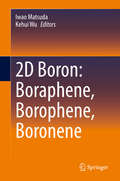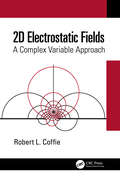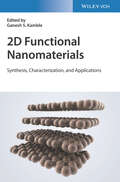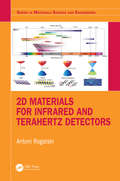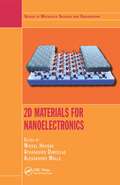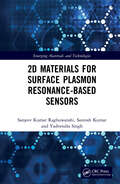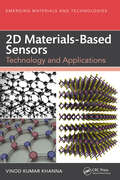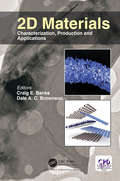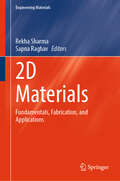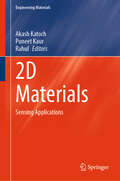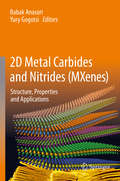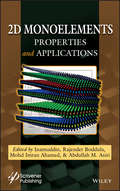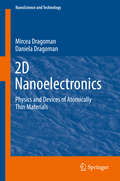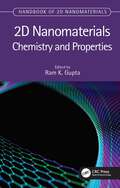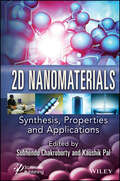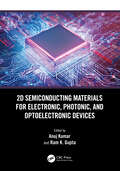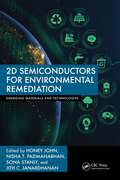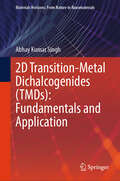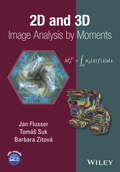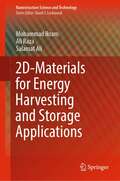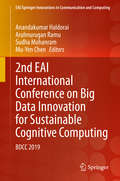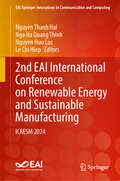- Table View
- List View
2D Boron: Boraphene, Borophene, Boronene
by Iwao Matsuda Kehui WuThis book addresses the development, properties, and applications of atomic-layered boron, or, borophene. The authors explain how borophene was predicted and created before investigating the properties that make it a desirable and useful material. The material is extremely thin and possesses exotic quantum states of new Dirac physics. Applications in superconductivity, plasmonics, and industrial chemical catalysis are examined, along with an examination of the material’s unique hydrogen boride and boron nitride forms. Given the varied potential uses for the new-developed borophene, this timely book will be useful to researchers in academia and industry.
2D Electrostatic Fields: A Complex Variable Approach
by Robert L. CoffieThis book demonstrates how to use functions of a complex variable to solve engineering problems that obey the 2D Laplace equation (and in some cases the 2D Poisson equation). The book was written with the engineer/physicist in mind and the majority of the book focuses on electrostatics. A key benefit of the complex variable approach to electrostatics is the visualization of field lines through the use of field maps. With todays’ powerful computers and mathematical software programs, field maps are easily generated once the complex potential has been determined. Additionally, problems that would have been considered out of scope previously are now easily solved with these mathematical software programs. For example, solutions requiring the use of non-elementary functions such as elliptic and hypergeometric functions would have been viewed as not practical in the past due to the tedious use of look up tables for evaluation. Now, elliptic and hypergeometric functions are built-in functions for most mathematical software programs making their evaluation as easy as a trigonometric function. Key highlights in the book include 2D electrostatics completely formulated in terms of complex variables More than 60 electrostatic field maps Comprehensive treatment for obtaining Green’s functions with conformal mapping Fully worked Schwarz-Christoffel transformations to more than usual number of problems A full chapter devoted to solving practical problems at an advanced level Detailed solutions to all end of chapter problems available on book’s website Although the text is primarily self-contained, the reader is assumed to have taken differential and integral calculus and introductory courses in complex variables and electromagnetics.
2D Functional Nanomaterials: Synthesis, Characterization, and Applications
by Ganesh S Kamble2D Functional Nanomaterials Outlines the latest developments in 2D heterojunction nanomaterials with energy conversion applications In 2D Functional Nanomaterials: Synthesis, Characterization, and Applications, Dr. Ganesh S. Kamble presents an authoritative overview of the most recent progress in the rational design and synthesis of 2D nanomaterials and their applications in semiconducting catalysts, biosensors, electrolysis, batteries, and solar cells. This interdisciplinary volume is a valuable resource for materials scientists, electrical engineers, nanoscientists, and solid-state physicists looking for up-to-date information on 2D heterojunction nanomaterials. The text summarizes the scientific contributions of international experts in the fabrication and application of 2D nanomaterials while discussing the importance and impact of 2D nanomaterials on future economic growth, novel manufacturing processes, and innovative products. Provides thorough coverage of graphene chemical derivatives synthesis and applications, including state-of-the-art developments and perspectives Describes 2D/2D graphene oxide-layered double hydroxide nanocomposites for immobilization of different radionuclides Covers 2D nanomaterials for biomedical applications and novel 2D nanomaterials for next-generation photodetectors Discusses applications of 2D nanomaterials for cancer therapy and recent trends ingraphene-latex nanocomposites Perfect for materials scientists, inorganic chemists, and electronics engineers, 2D Functional Nanomaterials: Synthesis, Characterization, and Applications is also an essential resource for solid-state physicists seeking accurate information on recent progress in two-dimensional heterojunction materials with energy conversion applications.
2D Materials for Infrared and Terahertz Detectors (Series in Materials Science and Engineering)
by Antoni Rogalski2D Materials for Infrared and Terahertz Detectors provides an overview of the performance of emerging detector materials, while also offering, for the first time, a comparison with traditional materials used in the fabrication of infrared and terahertz detectors. Since the discovery of graphene, its applications to electronic and optoelectronic devices have been intensively researched. The extraordinary electronic and optical properties allow graphene and other 2D materials to be promising candidates for infrared (IR) and terahertz (THz) photodetectors, and yet it appears that the development of new detectors using these materials is still secondary to those using traditional materials. This book explores this phenomenon, as well as the advantages and disadvantages of using 2D materials. Special attention is directed toward the identification of the most-effective hybrid 2D materials in infrared and terahertz detectors, as well as future trends. Written by one of the world’s leading researchers in the field of IR optoelectronics, this book will be a must-read for researchers and graduate students in photodetectors and related fields. Features • Offers a comprehensive overview of the different types of 2D materials used in fabrication of IR and THz detectors, and includes their advantages/disadvantages • The first book to compare new detectors to a wide family of common, commercially available detectors that use traditional materials.
2D Materials for Nanoelectronics (Series in Materials Science and Engineering)
by Michel Houssa Alessandro MolleMajor developments in the semiconductor industry are on the horizon through the use of two-dimensional (2D) materials, such as graphene and transition metal dichalcogenides, for integrated circuits (ICs). 2D Materials for Nanoelectronics is the first comprehensive treatment of these materials and their applications in nanoelectronic devices.Compris
2D Materials for Surface Plasmon Resonance-based Sensors (Emerging Materials and Technologies)
by Santosh Kumar Sanjeev Kumar Raghuwanshi Yadvendra Singh2D Materials for Surface Plasmon Resonance-based Sensors offers comprehensive coverage of recent design and development (including processing and fabrication) of 2D materials in the context of plasmonic-based devices. It provides a thorough overview of the basic principles and techniques used in the analysis and design of 2D material-based optical sensor systems. Beginning with the basic concepts of plasmon/plasmonic sensors and mathematical modelling, the authors explain the fundamental properties of 2D materials, including Black Phosphorus (BP), Phosphorene, Graphene, Transition metal dichalcogenides (TMDCs), MXene's and SW-CNT. It also details the applications of these emerging materials in clinical diagnosis and their future trends. This text will be useful for practising engineers, undergraduate and postgraduate students. Key Features Presents the fundamental concepts of 2D material assisted fibre optic and prism based SPR sensor in a student-friendly manner. Includes the recent synthesis and characterization techniques of 2D materials. Provides computational results of recently discovered electronic and optical properties of the 2D materials along with their effectiveness in the field of plasmonic sensors. Presents emerging applications of novel 2D material-based plasmonic sensors in the field of chemical, bio-chemical and biosensing.
2D Materials-Based Sensors: Technology and Applications (Emerging Materials and Technologies)
by Vinod Kumar Khanna2D Materials-Based Sensors: Technology and Applications is a comprehensive book covering the latest innovations on sensors using the unique properties of 2D materials. This specialized text: Key Features Describes 2D materials process technology and integration of these materials into sensor fabrication. Provides an in-depth coverage of the underlying physics, operation, and performance metrics of 2D materials-based sensors. Highlights state-of-the-art developments in 2D material sensors vis-à-vis challenges faced in their fabrication. Presents glimpses of emerging 2D materials-based sensor technologies that will shape the future. Expedites understanding and learning through plain, lucid explanations, and clear, insightful diagrams. Commencing from an introductory survey of the 2D materials family, the book describes their impressive properties and their top-down and bottom-up synthesis techniques. The succeeding chapters present detailed descriptions of 2D materials-based mechanical sensors, photodetectors, magnetic sensors together with quantum sensors, heavy-metal ion sensors, gas sensors, and biological sensors. The book concludes with the research challenges, emerging trends, and limitations providing a balanced perspective of this fast-progressing field. This book is a concise guide for students, scientists, and technologists engaged in sensor research and development.
2D Materials: Characterization, Production and Applications
by Craig E. Banks Dale A. BrownsonMost reference texts covering two-dimensional materials focus specifically on graphene, when in reality, there are a host of new two-dimensional materials poised to overtake graphene. This book provides an authoritative source of information on twodimensional materials covering a plethora of fields and subjects and outlining all two-dimensional materials in terms of their fundamental understanding, synthesis, and applications.
2D Materials: Fundamentals, Fabrication, and Applications (Engineering Materials)
by Rekha Sharma Sapna RaghavThis book provides an introduction to 2D materials, their current fabrication techniques, and characterization. It focuses on the wide applications of 2D materials in electromagnetic shielding applications, high power sensors, electrochemical energy storage, supercapacitors, photo detectors, medical and biomedical fields and energy storage devices. 2D materials such as graphene, transition metal dichalcogenides (TMD), MXenes and so on, have attracted a lot of attention because of their ability to be integrated in various functional devices.
2D Materials: Properties and Devices
by Heinz Phaedon Avouris Tony F. Tony LowLearn about the most recent advances in 2D materials with this comprehensive and accessible text. Providing all the necessary materials science and physics background, leading experts discuss the fundamental properties of a wide range of 2D materials, and their potential applications in electronic, optoelectronic and photonic devices. Several important classes of materials are covered, from more established ones such as graphene, hexagonal boron nitride, and transition metal dichalcogenides, to new and emerging materials such as black phosphorus, silicene, and germanene. Readers will gain an in-depth understanding of the electronic structure and optical, thermal, mechanical, vibrational, spin and plasmonic properties of each material, as well as the different techniques that can be used for their synthesis. Presenting a unified perspective on 2D materials, this is an excellent resource for graduate students, researchers and practitioners working in nanotechnology, nanoelectronics, nanophotonics, condensed matter physics, and chemistry.
2D Materials: Sensing Applications (Engineering Materials)
by Akash Katoch Puneet Kaur RahulThis book summarizes various scalable and cost-effective techniques to fabricate different 2D materials beyond graphene including, but not limited to, transition metal dichalcognides (TMDs), MXenes, Transition Metal Oxides (TMOs), etc. This book focuses on recent advancements in the field of sensors based on these 2D materials and their heterostructures. These materials exhibit a wide range of sensing applications and have become one of the potential research areas for the scientific community due to their exceptional and tunable properties. This book provides basic and fundamental knowledge about various sensing mechanisms, challenges, and future opportunities for the fabrication/development of the next-generation sensors with applications in daily lives.
2D Metal Carbides and Nitrides (MXenes): Structure, Properties and Applications
by Yury Gogotsi Babak AnasoriThis book describes the rapidly expanding field of two-dimensional (2D) transition metal carbides and nitrides (MXenes). It covers fundamental knowledge on synthesis, structure, and properties of these new materials, and a description of their processing, scale-up and emerging applications. The ways in which the quickly expanding family of MXenes can outperform other novel nanomaterials in a variety of applications, spanning from energy storage and conversion to electronics; from water science to transportation; and in defense and medical applications, are discussed in detail.
2D Monoelemental Materials: Beyond Graphene (Emerging Materials and Technologies)
by Zongyu Huang, Xiang Qi, and Jianxin ZhongMonoelemental 2D materials called Xenes have a graphene-like structure, intra-layer covalent bond, and weak van der Waals forces between layers. Materials composed of different groups of elements have different structures and rich properties, making Xenes materials a potential candidate for the next generation of 2D materials. 2D Monoelemental Materials (Xenes) and Related Technologies: Beyond Graphene describes the structure, properties, and applications of Xenes by classification and section. The first section covers the structure and classification of single-element 2D materials, according to the different main groups of monoelemental materials of different components and includes the properties and applications with detailed description. The second section discusses the structure, properties, and applications of advanced 2D Xenes materials, which are composed of heterogeneous structures, produced by defects, and regulated by the field. Features include: Systematically detailed single element materials according to the main groups of the constituent elements Classification of the most effective and widely studied 2D Xenes materials Expounding upon changes in properties and improvements in applications by different regulation mechanisms Discussion of the significance of 2D single-element materials where structural characteristics are closely combined with different preparation methods and the relevant theoretical properties complement each other with practical applications Aimed at researchers and advanced students in materials science and engineering, this book offers a broad view of current knowledge in the emerging and promising field of 2D monoelemental materials.
2D Monoelements: Properties and Applications
by Abdullah M. Asiri Mohd Imran Ahamed Rajender Boddula Inamuddin2D Monoelements: Properties and Applications explores the challenges, research progress and future developments of the basic idea of two-dimensional monoelements, classifications, and application in field-effect transistors for sensing and biosensing. The thematic topics include investigations such as: Recent advances in phosphorene The diverse properties of two-dimensional antimonene, of graphene and its derivatives The molecular docking simulation study used to analyze the binding mechanisms of graphene oxide as a cancer drug carrier Metal-organic frameworks (MOFs)-derived carbon (graphene and carbon nanotubes) and MOF-carbon composite materials, with a special emphasis on the use of these nanostructures for energy storage devices (supercapacitors) Two-dimensional monoelements classification like graphene application in field-effect transistors for sensing and biosensing Graphene-based ternary materials as a supercapacitor electrode Rise of silicene and its applications in gas sensing
2D Nanoelectronics: Physics and Devices of Atomically Thin Materials (NanoScience and Technology)
by Mircea Dragoman Daniela DragomanThis book is dedicated to the new two-dimensional one-atomic-layer-thick materials such as graphene, metallic chalcogenides, silicene and other 2D materials. The book describes their main physical properties and applications in nanoelctronics, photonics, sensing and computing. A large part of the book deals with graphene and its amazing physical properties. Another important part of the book deals with semiconductor monolayers such as MoS2 with impressive applications in photonics, and electronics. Silicene and germanene are the atom-thick counterparts of silicon and germanium with impressive applications in electronics and photonics which are still unexplored. Consideration of two-dimensional electron gas devices conclude the treatment. The physics of 2DEG is explained in detail and the applications in THz and IR region are discussed. Both authors are working currently on these 2D materials developing theory and applications.
2D Nanomaterials for Energy and Environmental Sustainability (Materials Horizons: From Nature to Nanomaterials)
by Zeba Khanam Neelam Gogoi Divesh Narayan SrivastavaThis book presents cutting-edge research, recent breakthroughs, and unresolved challenges associated with 2D nanomaterials to combat energy and environmental issues. The book discusses the state-of-the-art design and innovations engaged to novel 2D nanomaterials, viz. Transition metal compounds (TMDs, TMOs, TMHs), MXenes, elemental 2D analogs (silicene, phosphorene, arsenene, etc.), Metal-organic frameworks (MOFs), etc. It presents the latest trends on top-down and bottom-up synthesis approaches and properties followed by the critical status and progress of these 2D nanomaterials in the field of energy and environment. The topics cover wide spectrum of 2D nanomaterials applications including energy storage/conversion, air/water/soil remediation, adsorption, photocatalytic degradation, desalination and membrane filtration, detection and sensing, drug delivery systems, and nano-encapsulated agro-formulations. The subsequent section includes a comprehensive account on the safety risk assessment of 2D nanomaterials towards the ecosystem and human health. This book will be beneficial for beginners, researchers, and professionals from diverse fields interested in 2D nanomaterials for energy and environmental sustainability.
2D Nanomaterials: Chemistry and Properties
by Ram K. Gupta2D nanomaterials have emerged as promising candidates for use in energy devices owing to their superior electrochemical properties, surface area, nanodevice integration, multifunctionality, printability, and mechanical flexibility. 2D Nanomaterials: Chemistry and Properties covers basic concepts, chemistries, and properties along with theoretical considerations in designing new 2D nanomaterials, especially for energy applications. This book: Discusses the effect of doping, structural variation, phase, and exfoliation on structural and electrochemical properties of 2D nanomaterials Presents synthesis, characterization, and applications of 2D materials for green energy production and storage Explores new aspects of synthesizing 2D nanomaterials beyond traditionally layered structures Examines challenges in using 2D materials for energy applications This book is aimed at materials scientists, chemists, electrochemists, and engineers working in energy disciplines.
2D Nanomaterials: Synthesis, Properties, and Applications
by Kaushik Pal Subhendu Chakroborty2D NANOMATERIALS The book provides a comprehensive overview of the synthesis, modification, characterization, and application of 2D nanomaterials. In recent years, 2D nanomaterials have emerged as a remarkable cornerstone in the field of advanced materials research, with their unique properties and versatile applications captivating the attention of scientists and engineers worldwide. This book is a testament to the ever-growing interest and importance of 2D nanomaterials in the realm of materials science, nanotechnology, pharmaceuticals, and a myriad of engineering specializations. The book is structured into three sections, each delving into different aspects of 2D nanomaterials. The first section explores the synthesis of these materials, providing an overview of both top-down and bottom-up strategies. Understanding the methods by which these materials can be synthesized is crucial for advancing their potential applications. Additionally, this section details the structural characterization of 2D nanomaterials, shedding light on their intricate compositions and properties. The second section examines the diverse characteristics exhibited by 2D nanomaterials. From their magnetic and mechanical properties to their electrical, plasmonic, and optical behaviors, these materials possess an array of intriguing attributes that make them highly attractive for a wide range of applications. This section of the book provides a comprehensive understanding of these properties, enabling readers to appreciate the unique potential of 2D nanomaterials. The final section focuses on the applications of 2D nanomaterials, highlighting their use in various fields such as energy, water purification, biomedical applications, multimodal tumor therapy, and supercapacitor technology.
2D Semiconducting Materials for Electronic, Photonic, and Optoelectronic Devices
by Anuj Kumar Ram K. GuptaTwo-dimensional semiconducting materials (2D-SCMs) are the subject of intensive study in the fields of photonics and optoelectronics because of their unusual optical, electrical, thermal, and mechanical properties. The main objective of 2D Semiconducting Materials for Electronic, Photonic, and Optoelectronic Devices is to provide current, state-of-the-art knowledge of two-dimensional semiconducting materials for various applications. Two-dimensional semiconducting materials are the basic building blocks for making photodiodes, light-emitting diodes, light-detecting devices, data storage, telecommunications, and energy-storage devices. When it comes to two-dimensional semiconducting materials, electronic, photonic, and optoelectronic applications, as well as future plans for improving performance, no modern book covers as much ground. The planned book will fill such gaps by offering a comprehensive analysis of two-dimensional semiconducting materials. This book covers a range of advanced 2D materials, their fundamentals, and the chemistry for many emerging applications. All the chapters are covered by experts in these areas around the world, making this a suitable textbook for students and providing new guidelines to researchers and industries. • Covers topics such as fundamentals and advanced knowledge of two-dimensional semiconducting materials • Provides details about the recent methods used for the synthesis, characterization, and applications of two-dimensional semiconducting materials • Covers the state-of-the-art development in two-dimensional semiconducting materials and their emerging applications This book provides directions to students, scientists, and researchers in semiconductors and related disciplines to help them better understand the physics, characteristics, and applications of 2D semiconductors.
2D Semiconductors for Environmental Remediation (Emerging Materials and Technologies)
by Honey John Nisha T. Padmanabhan Sona Stanly Jith C. JanardhananThis book gives a comprehensive description of various aspects of 2D semiconductors including their synthesis, surface science, characterizations, and their allied application in environmental remediation including air and water purification, oil-water separation, hydrogen production, and CO2 removal. The electronic and optoelectronic enhancement properties of these semiconductors with bandgap engineering, doping, and chemical functionalization for various applications are exemplified.Features: Provides focus on the application of 2D semiconductors for environmental applications. Covers the fundamental understanding of material design, fabrication, defect engineering, physical and chemical properties of 2D semiconductors, and their advantages for environmental applications. Focuses on the reliable future perspectives and developments that lead to advanced research in utilizing 2D materials for large-scale exploration and commercial deployment. Explores an in-depth insight into various aspects and processes for environmental remediation. Details the importance of 2D semiconductors over other 0D, 1D, or 3D semiconductors. This book is aimed at researchers and graduate students in materials science and environmental engineering.
2D Transition-Metal Dichalcogenides (Materials Horizons: From Nature to Nanomaterials)
by Abhay Kumar SinghThis book offers to reader a sound understating of two-dimensional Transition-Metal Dichalcogenides (2D TMDs) materials, detailing their physio-chemical mechanisms and technological applications in various areas such as nanoelectronics and optoelectronics. Moving from their invention to their modern developments, including theoretical approaches, experimental interpretations and their technical applications, the book explores the basic concepts of 2D TMDs. It will be of interest to undergraduate and postgraduate students, researchers and scientists working in the area of 2D TMDs. A key goal of this book provides a sound or clear idea about two-dimensional Transition-Metal Dichalcogenides (2D TMDs) materials by providing their sound background, fabrication approaches including interpretations of the inside physio-chemical mechanism including technological applications in various significant areas such as nanoelectronics, optoelectronics, topological insulators, biomedical.
2D and 3D Image Analysis by Moments
by Barbara Zitova Jan Flusser Tomas SukPresents recent significant and rapid development in the field of 2D and 3D image analysis 2D and 3D Image Analysis by Moments, is a unique compendium of moment-based image analysis which includes traditional methods and also reflects the latest development of the field. The book presents a survey of 2D and 3D moment invariants with respect to similarity and affine spatial transformations and to image blurring and smoothing by various filters. The book comprehensively describes the mathematical background and theorems about the invariants but a large part is also devoted to practical usage of moments. Applications from various fields of computer vision, remote sensing, medical imaging, image retrieval, watermarking, and forensic analysis are demonstrated. Attention is also paid to efficient algorithms of moment computation. Key features: Presents a systematic overview of moment-based features used in 2D and 3D image analysis. Demonstrates invariant properties of moments with respect to various spatial and intensity transformations. Reviews and compares several orthogonal polynomials and respective moments. Describes efficient numerical algorithms for moment computation. It is a "classroom ready" textbook with a self-contained introduction to classifier design. The accompanying website contains around 300 lecture slides, Matlab codes, complete lists of the invariants, test images, and other supplementary material. 2D and 3D Image Analysis by Moments, is ideal for mathematicians, computer scientists, engineers, software developers, and Ph.D students involved in image analysis and recognition. Due to the addition of two introductory chapters on classifier design, the book may also serve as a self-contained textbook for graduate university courses on object recognition.
2D-Materials for Energy Harvesting and Storage Applications (Nanostructure Science and Technology)
by Ali Raza Muhammad Ikram Salamat AliThis authored monograph presents the state-of-the-art improvements in 2D materials, focusing on their most significant achievements, as well as recent emergence and potential applications. The book discusses synthetic protocols as well as the structural chemistry and physical properties of various 2D materials and explores their energy-related utilization. The main energy harvesting applications such as piezoelectric generators, solar cells and hydrogen evolution reactions are analyzed, while special focus is also given to the related energy storage technologies such as rechargeable batteries, supercapacitors and wearable energy storage devices. This volume sheds new light on 2D materials and their applications and will be a useful tool for graduates and academics working in the fields of materials science, materials physics and chemistry.
2nd EAI International Conference on Big Data Innovation for Sustainable Cognitive Computing: BDCC 2019 (EAI/Springer Innovations in Communication and Computing)
by Anandakumar Haldorai Arulmurugan Ramu Sudha Mohanram Mu-Yen ChenThis proceeding features papers discussing big data innovation for sustainable cognitive computing. The papers feature details on cognitive computing and its self-learning systems that use data mining, pattern recognition and natural language processing (NLP) to mirror the way the human brain works. This international conference focuses on cognitive computing technologies, from knowledge representation techniques and natural language processing algorithms to dynamic learning approaches. Topics covered include Data Science for Cognitive Analysis, Real-Time Ubiquitous Data Science, Platform for Privacy Preserving Data Science, and Internet-Based Cognitive Platform. The 2nd EAI International Conference on Big Data Innovation for Sustainable Cognitive Computing (BDCC 2019) took place in Coimbatore, India on December 12-13, 2019.Contains proceedings from 2nd EAI International Conference on Big Data Innovation for Sustainable Cognitive Computing (BDCC 2019), Coimbatore, India, December 12-13, 2019;Features topics ranging from Data Science for Cognitive Analysis to Internet-Based Cognitive Platforms;Includes contributions from researchers, academics, and professionals from around the world.
2nd EAI International Conference on Renewable Energy and Sustainable Manufacturing: ICRESM 2024 (EAI/Springer Innovations in Communication and Computing)
by Nguyen Thanh Hai Ngo Ha Quang Thinh Nguyen Huu Loc Le Chi HiepThis book compiles the proceedings of the 2nd EAI International Conference on Renewable Energy and Sustainable Manufacturing (ICRESM 2024), held in Ho Chi Minh City, Vietnam, on November 2–3, 2024. The conference provided a collaborative forum for researchers, industry experts, policymakers, and stakeholders to exchange insights, innovations, and best practices in sustainable technologies aimed at reducing dependence on non-renewable resources and advancing Industry 4.0 initiatives. The included papers explore global challenges in sustainable manufacturing, energy security, and green technologies, highlighting applications that contribute to carbon emission reduction, environmental protection, and economic growth through renewable energy and eco-friendly production methods. This collection offers valuable perspectives on the latest technological developments, methodologies, and strategies driving progress in these fields. Features the proceedings of the 2nd EAI International Conference on Renewable Energy and Sustainable Manufacturing; Showcases advancements in renewable energy and sustainable manufacturing technologies; Provides valuable insights for researchers, practitioners, and policymakers interested in cutting-edge innovations and best practices.
